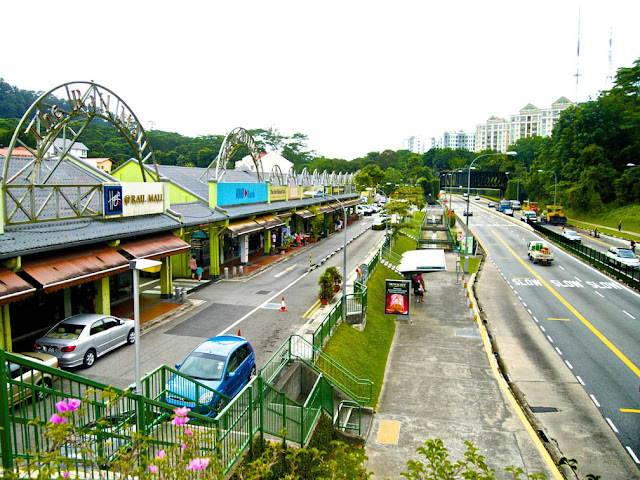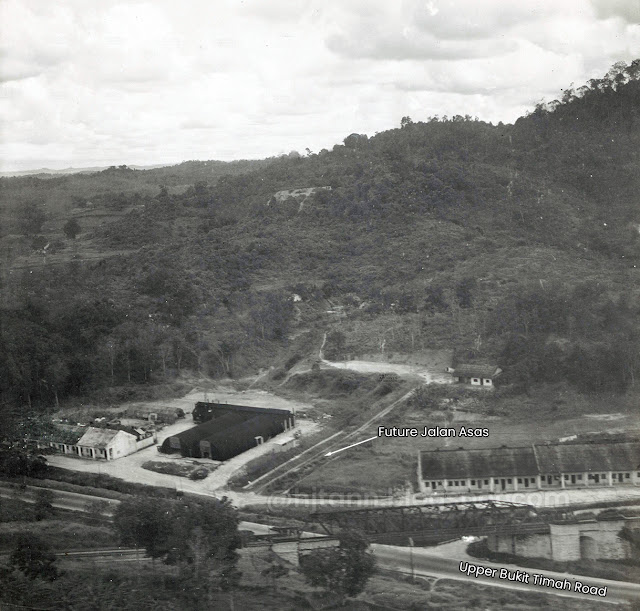 |
| Rail Mall at Upper Bukit Timah. |
Philanthropist Lee Kong Chian owned the entire swathe of land on the eastern side of Upper Bukit Timah Road 14km (9-1/2ms) from the Singapore Quarry to the PWD Quarry at Dairy Farm.
On this hillside, he planted rubber trees and the rubber estate became part of the Lee Rubber Plantation conglomerate.
After World War II, in order to provide decent living quarters and accomodation for his plantation workers and their families, Lee Kong Chian, in 1947, built four rows of workmen houses called artisan quarters at the edge of his rubber plantation.
Each row had twelve units. Each unit had two small bedrooms and a small living room with an attached kitchen. At the rear of each unit there was a small open-air yard where a separate bucket system toilet was set apart away from the living space.
At the beginning, there was no electricity and using kerosene lamps was the only way to get illumination at night. But back then, it would have been almost a luxury for manual workers, considering that most people were living in kampong attap houses. A real luxury was fresh water direct from the tap within their own household.
At the beginning, there was no electricity and using kerosene lamps was the only way to get illumination at night. But back then, it would have been almost a luxury for manual workers, considering that most people were living in kampong attap houses. A real luxury was fresh water direct from the tap within their own household.
This was how it looked in 1947 when the worker's homes were built. You can see most of the hill slope at the back covered with rubber trees. Two rows of the terraced homes visible are separated by some buildings which may be part of the rubber plantation processing facility. If anyone knows what these buildings are, please drop me a comment below. The path beside the black building would be transformed into Jalan Asas in future. A prominent landmark here is the black truss bridge that carried the KTM Railway line and crossed Upper Bukit Timah Road here (bottom right).
In the 1950s, more of the rubber plantation was given up to build a private housing estate. This was Fuyong Estate, that was also developed by the Lee Foundation, comprising terraced, semi-detached and detached bungalow houses.
The original four rows of workmen's quarters were then sold or rented out as there was no longer a need for plantation workers due to the fall in demand for natural rubber. These workman quarters were mostly converted into shophouses for various trades ranging from tailoring, provision shops to motor workshops and coffee shops.
In the 1950s, more of the rubber plantation was given up to build a private housing estate. This was Fuyong Estate, that was also developed by the Lee Foundation, comprising terraced, semi-detached and detached bungalow houses.
The original four rows of workmen's quarters were then sold or rented out as there was no longer a need for plantation workers due to the fall in demand for natural rubber. These workman quarters were mostly converted into shophouses for various trades ranging from tailoring, provision shops to motor workshops and coffee shops.
 |
| Click on the picture for a detailed view. |
This is an aerial view of the land owned by the Lee Foundation, between the Dairy Farm Quarry (left) to the Singapore Quarry (right.)
The Lee Kuo Chuan Children's Home was built on land donated by Lee Kong Chian to the Salvation Army for them to run a Children's Orphanage.
The Lee Kuo Chuan Children's Home was built on land donated by Lee Kong Chian to the Salvation Army for them to run a Children's Orphanage.
In 1995, the 4 rows of shophouses were re-acquired by a Lee Foundation company called Pulau Properties, who then created the shopping arcade called Rail Mall. After 2018, it was sold to the SPH group.
Related links:-
Fuyong Estate
Chia Eng Say's Singapore Quarry
Dairy Farm
The Rail Mall
Related links:-
Fuyong Estate
Chia Eng Say's Singapore Quarry
Dairy Farm
The Rail Mall

